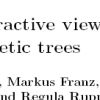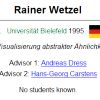|
|
|
|
|
|
|
|
|
|
|
|
|
|
|
|
| |
   
Benjamin Albrecht,
Celine Scornavacca,
Alberto Cenci and
Daniel H. Huson. Fast computation of minimum hybridization networks. In BIO, Vol. 28(2):191-197, 2012.
Keywords: explicit network, from rooted trees, minimum number, phylogenetic network, phylogeny, Program Dendroscope, Program Hybroscale, reconstruction.
Note: http://dx.doi.org/10.1093/bioinformatics/btr618.
Toggle abstract
"Motivation: Hybridization events in evolution may lead to incongruent gene trees. One approach to determining possible interspecific hybridization events is to compute a hybridization network that attempts to reconcile incongruent gene trees using a minimum number of hybridization events. Results: We describe how to compute a representative set of minimum hybridization networks for two given bifurcating input trees, using a parallel algorithm and provide a user-friendly implementation. A simulation study suggests that our program performs significantly better than existing software on biologically relevant data. Finally, we demonstrate the application of such methods in the context of the evolution of the Aegilops/Triticum genera. Availability and implementation: The algorithm is implemented in the program Dendroscope 3, which is freely available from www.dendroscope.org and runs on all three major operating systems. © The Author 2011. Published by Oxford University Press. All rights reserved."
|
|
| |
 
Daniel H. Huson and
Celine Scornavacca. Dendroscope 3: An Interactive Tool for Rooted Phylogenetic Trees and Networks. In Systematic Biology, Vol. 61(6):1061-1067, 2012.
Keywords: from rooted trees, from triplets, phylogenetic network, phylogeny, Program Dendroscope, reconstruction, software, visualization.
Toggle abstract
"Dendroscope 3 is a new program for working with rooted phylogenetic trees and networks. It provides a number of methods for drawing and comparing rooted phylogenetic networks, and for computing them from rooted trees. The program can be used interactively or in command-line mode. The program is written in Java, use of the software is free, and installers for all 3 major operating systems can be downloaded from www.dendroscope.org. [Phylogenetic trees; phylogenetic networks; software.] © 2012 The Author(s)."
|
|
|
|
|
|
| |
 
Daniel H. Huson and
Celine Scornavacca. A survey of combinatorial methods for phylogenetic networks. In Genome Biology and Evolution, Vol. 3:23-35, 2011.
Keywords: phylogenetic network, survey.
Note: http://dx.doi.org/10.1093/gbe/evq077.
Toggle abstract
"The evolutionary history of a set of species is usually described by a rooted phylogenetic tree. Although it is generally undisputed that bifurcating speciation events and descent with modifications are major forces of evolution, there is a growing belief that reticulate events also have a role to play. Phylogenetic networks provide an alternative to phylogenetic trees and may be more suitable for data sets where evolution involves significant amounts of reticulate events, such as hybridization, horizontal gene transfer, or recombination. In this article, we give an introduction to the topic of phylogenetic networks, very briefly describing the fundamental concepts and summarizing some of the most important combinatorial methods that are available for their computation. © 2010 The Author(s)."
|
|
| |
|
| |
 
Celine Scornavacca,
Franziska Zickmann and
Daniel H. Huson. Tanglegrams for Rooted Phylogenetic Trees and Networks. In ISMB11, Vol. 27(13):i248-i256 of BIO, 2011.
Keywords: from network, heuristic, integer linear programming, phylogenetic network, phylogeny, Program Dendroscope, tanglegram, visualization.
Note: http://dx.doi.org/10.1093/bioinformatics/btr210.
Toggle abstract
"Motivation: In systematic biology, one is often faced with the task of comparing different phylogenetic trees, in particular in multi-gene analysis or cospeciation studies. One approach is to use a tanglegram in which two rooted phylogenetic trees are drawn opposite each other, using auxiliary lines to connect matching taxa. There is an increasing interest in using rooted phylogenetic networks to represent evolutionary history, so as to explicitly represent reticulate events, such as horizontal gene transfer, hybridization or reassortment. Thus, the question arises how to define and compute a tanglegram for such networks. Results: In this article, we present the first formal definition of a tanglegram for rooted phylogenetic networks and present a heuristic approach for computing one, called the NN-tanglegram method. We compare the performance of our method with existing tree tanglegram algorithms and also show a typical application to real biological datasets. For maximum usability, the algorithm does not require that the trees or networks are bifurcating or bicombining, or that they are on identical taxon sets. © The Author(s) 2011. Published by Oxford University Press."
|
|
|
|
|
|
| |
 
Johannes Fischer and
Daniel H. Huson. New Common Ancestor Problems in Trees and Directed Acyclic Graphs. In IPL, Vol. 110(8-9):331-335, 2010.
Keywords: explicit network, phylogenetic network, polynomial.
Note: http://www-ab.informatik.uni-tuebingen.de/people/fischer/lsa.pdf.
Toggle abstract
"We derive a new generalization of lowest common ancestors (LCAs) in dags, called the lowest single common ancestor (LSCA). We show how to preprocess a static dag in linear time such that subsequent LSCA-queries can be answered in constant time. The size is linear in the number of nodes. We also consider a "fuzzy" variant of LSCA that allows to compute a node that is only an LSCA of a given percentage of the query nodes. The space and construction time of our scheme for fuzzy LSCAs is linear, whereas the query time has a sub-logarithmic slow-down. This "fuzzy" algorithm is also applicable to LCAs in trees, with the same complexities. © 2010 Elsevier B.V. All rights reserved."
|
|
| |
   
Leo van Iersel,
Steven Kelk,
Regula Rupp and
Daniel H. Huson. Phylogenetic Networks Do not Need to Be Complex: Using Fewer Reticulations to Represent Conflicting Clusters. In ISMB10, Vol. 26(12):i124-i131 of BIO, 2010.
Keywords: from clusters, level k phylogenetic network, Program Dendroscope, Program HybridInterleave, Program HybridNumber, reconstruction.
Note: http://dx.doi.org/10.1093/bioinformatics/btq202, with proofs: http://arxiv.org/abs/0910.3082.
Toggle abstract
"Phylogenetic trees are widely used to display estimates of how groups of species are evolved. Each phylogenetic tree can be seen as a collection of clusters, subgroups of the species that evolved from a common ancestor. When phylogenetic trees are obtained for several datasets (e.g. for different genes), then their clusters are often contradicting. Consequently, the set of all clusters of such a dataset cannot be combined into a single phylogenetic tree. Phylogenetic networks are a generalization of phylogenetic trees that can be used to display more complex evolutionary histories, including reticulate events, such as hybridizations, recombinations and horizontal gene transfers. Here, we present the new CASS algorithm that can combine any set of clusters into a phylogenetic network. We show that the networks constructed by CASS are usually simpler than networks constructed by other available methods. Moreover, we show that CASS is guaranteed to produce a network with at most two reticulations per biconnected component, whenever such a network exists. We have implemented CASS and integrated it into the freely available Dendroscope software. Contact: l.j.j.v.iersel@gmail.com. Supplementary information: Supplementary data are available at Bioinformatics online. © The Author(s) 2010. Published by Oxford University Press."
|
|
|
|
|
|
| |

Daniel H. Huson. Drawing Rooted Phylogenetic Networks. In TCBB, Vol. 6(1):103-109, 2009.
Keywords: explicit network, phylogenetic network, phylogeny, Program Dendroscope, Program SplitsTree, visualization.
Note: http://dx.doi.org/10.1109/TCBB.2008.58.
Toggle abstract
"The evolutionary history of a collection of species is usually represented by a phylogenetic tree. Sometimes, phylogenetic networks are used as a means of representing reticulate evolution or of showing uncertainty and incompatibilities in evolutionary datasets. This is often done using unrooted phylogenetic networks such as split networks, due in part, to the availability of software (SplitsTree) for their computation and visualization. In this paper we discuss the problem of drawing rooted phylogenetic networks as cladograms or phylograms in a number of different views that are commonly used for rooted trees. Implementations of the algorithms are available in new releases of the Dendroscope and SplitsTree programs. © 2006 IEEE."
|
|
| |
    
Daniel H. Huson,
Regula Rupp,
Vincent Berry,
Philippe Gambette and
Christophe Paul. Computing Galled Networks from Real Data. In ISMBECCB09, Vol. 25(12):i85-i93 of BIO, 2009.
Keywords: abstract network, cluster containment, explicit network, FPT, from clusters, from rooted trees, galled network, NP complete, phylogenetic network, phylogeny, polynomial, Program Dendroscope, reconstruction.
Note: http://hal-lirmm.ccsd.cnrs.fr/lirmm-00368545/en/.
Toggle abstract
"Motivation: Developing methods for computing phylogenetic networks from biological data is an important problem posed by molecular evolution and much work is currently being undertaken in this area. Although promising approaches exist, there are no tools available that biologists could easily and routinely use to compute rooted phylogenetic networks on real datasets containing tens or hundreds of taxa. Biologists are interested in clades, i.e. groups of monophyletic taxa, and these are usually represented by clusters in a rooted phylogenetic tree. The problem of computing an optimal rooted phylogenetic network from a set of clusters, is hard, in general. Indeed, even the problem of just determining whether a given network contains a given cluster is hard. Hence, some researchers have focused on topologically restricted classes of networks, such as galled trees and level-k networks, that are more tractable, but have the practical draw-back that a given set of clusters will usually not possess such a representation. Results: In this article, we argue that galled networks (a generalization of galled trees) provide a good trade-off between level of generality and tractability. Any set of clusters can be represented by some galled network and the question whether a cluster is contained in such a network is easy to solve. Although the computation of an optimal galled network involves successively solving instances of two different NP-complete problems, in practice our algorithm solves this problem exactly on large datasets containing hundreds of taxa and many reticulations in seconds, as illustrated by a dataset containing 279 prokaryotes. © 2009 The Author(s)."
|
|
|
|
|
|
| |
 
Philippe Gambette and
Daniel H. Huson. Improved Layout of Phylogenetic Networks. In TCBB, Vol. 5(3):472-479, 2008.
Keywords: abstract network, heuristic, phylogenetic network, phylogeny, Program SplitsTree, software, split network, visualization.
Note: http://hal-lirmm.ccsd.cnrs.fr/lirmm-00309694/en/.
Toggle abstract
"Split networks are increasingly being used in phylogenetic analysis. Usually, a simple equal-angle algorithm is used to draw such networks, producing layouts that leave much room for improvement. Addressing the problem of producing better layouts of split networks, this paper presents an algorithm for maximizing the area covered by the network, describes an extension of the equal-daylight algorithm to networks, looks into using a spring embedder, and discusses how to construct rooted split networks. © 2008 IEEE."
|
|
| |
 
Tobias Kloepper and
Daniel H. Huson. Drawing explicit phylogenetic networks and their integration into SplitsTree. In BMCEB, Vol. 8(22), 2008.
Keywords: explicit network, phylogenetic network, phylogeny, Program SplitsTree, software, split network, visualization.
Note: http://dx.doi.org/10.1186/1471-2148-8-22.
Toggle abstract
"Background. SplitsTree provides a framework for the calculation of phylogenetic trees and networks. It contains a wide variety of methods for the import/export, calculation and visualization of phylogenetic information. The software is developed in Java and implements a command line tool as well as a graphical user interface. Results. In this article, we present solutions to two important problems in the field of phylogenetic networks. The first problem is the visualization of explicit phylogenetic networks. To solve this, we present a modified version of the equal angle algorithm that naturally integrates reticulations into the layout process and thus leads to an appealing visualization of these networks. The second problem is the availability of explicit phylogenetic network methods for the general user. To advance the usage of explicit phylogenetic networks by biologists further, we present an extension to the SplitsTree framework that integrates these networks. By addressing these two problems, SplitsTree is among the first programs that incorporates implicit and explicit network methods together with standard phylogenetic tree methods in a graphical user interface environment. Conclusion. In this article, we presented an extension of SplitsTree 4 that incorporates explicit phylogenetic networks. The extension provides a set of core classes to handle explicit phylogenetic networks and a visualization of these networks. © 2008 Kloepper and Huson; licensee BioMed Central Ltd."
|
|
| |
   
James B. Whitfield,
Sydney A. Cameron,
Daniel H. Huson and
Mike Steel. Filtered Z-Closure Supernetworks for Extracting and Visualizing Recurrent Signal from Incongruent Gene Trees. In Systematic Biology, Vol. 57(6):939-947, 2008.
Keywords: abstract network, from unrooted trees, phylogenetic network, phylogeny, Program SplitsTree, split, split network, supernetwork.
Note: http://www.life.uiuc.edu/scameron/pdfs/Filtered%20Z-closure%20SystBiol.pdf.
|
|
| |
 
Daniel H. Huson and
Regula Rupp. Summarizing Multiple Gene Trees Using Cluster Networks. In WABI08, Vol. 5251:296-305 of LNCS, springer, 2008.
Keywords: abstract network, from clusters, from rooted trees, phylogenetic network, phylogeny, polynomial, Program Dendroscope.
Note: http://dx.doi.org/10.1007/978-3-540-87361-7_25, slides from the MIEP Conference available at http://www.lirmm.fr/MIEP08/slides/11_13_rupp.pdf.
Toggle abstract
"The result of a multiple gene tree analysis is usually a number of different tree topologies that are each supported by a significant proportion of the genes. We introduce the concept of a cluster network that can be used to combine such trees into a single rooted network, which can be drawn either as a cladogram or phylogram. In contrast to split networks, which can grow exponentially in the size of the input, cluster networks grow only quadratically. A cluster network is easily computed using a modification of the tree-popping algorithm, which we call network-popping. The approach has been implemented as part of the Dendroscope tree-drawing program and its application is illustrated using data and results from three recent studies on large numbers of gene trees. © 2008 Springer-Verlag Berlin Heidelberg."
|
|
|
|
|
|
| |
 
Daniel H. Huson and
Tobias Kloepper. Beyond Galled Trees - Decomposition and Computation of Galled Networks. In RECOMB07, Vol. 4453:211-225 of LNCS, springer, 2007.
Keywords: FPT, from splits, from trees, galled network, phylogenetic network, phylogeny, Program SplitsTree, reconstruction.
Note: http://dx.doi.org/10.1007/978-3-540-71681-5_15, errata..
|
|
| |

Daniel H. Huson. Split networks and Reticulate Networks. In
Olivier Gascuel and
Mike Steel editors, Reconstructing Evolution, New Mathematical and Computational Advances, Pages 247-276, Oxford University Press, 2007.
Keywords: abstract network, consensus, from rooted trees, from sequences, from splits, from unrooted trees, galled tree, hybridization, phylogenetic network, phylogeny, Program Beagle, Program Spectronet, Program SplitsTree, Program SPNet, recombination, reconstruction, split network, survey.
Note: similar to http://www-ab.informatik.uni-tuebingen.de/research/phylonets/GCB2006.pdf.
|
|
| |
     
Daniel H. Huson,
Daniel C. Richter,
Christian Rausch,
Tobias Dezulian,
Markus Franz and
Regula Rupp. Dendroscope: An interactive viewer for large phylogenetic trees. In BMCB, Vol. 8:460, 2007.
Keywords: phylogeny, Program Dendroscope, software, visualization.
Note: http://dx.doi.org/10.1186/1471-2105-8-460, slides available at http://www.newton.cam.ac.uk/webseminars/pg+ws/2007/plg/plgw01/0903/huson/, software freely available from http://www.dendroscope.org.
Toggle abstract
"Background: Research in evolution requires software for visualizing and editing phylogenetic trees, for increasingly very large datasets, such as arise in expression analysis or metagenomics, for example. It would be desirable to have a program that provides these services in an effcient and user-friendly way, and that can be easily installed and run on all major operating systems. Although a large number of tree visualization tools are freely available, some as a part of more comprehensive analysis packages, all have drawbacks in one or more domains. They either lack some of the standard tree visualization techniques or basic graphics and editing features, or they are restricted to small trees containing only tens of thousands of taxa. Moreover, many programs are diffcult to install or are not available for all common operating systems. Results: We have developed a new program, Dendroscope, for the interactive visualization and navigation of phylogenetic trees. The program provides all standard tree visualizations and is optimized to run interactively on trees containing hundreds of thousands of taxa. The program provides tree editing and graphics export capabilities. To support the inspection of large trees, Dendroscope offers a magnification tool. The software is written in Java 1.4 and installers are provided for Linux/Unix, MacOS X and Windows XP. Conclusion: Dendroscope is a user-friendly program for visualizing and navigating phylogenetic trees, for both small and large datasets. © 2007 Huson et al; licensee BioMed Central Ltd."
|
|
|
|
|
|
| |
 
Daniel H. Huson and
David Bryant. Application of Phylogenetic Networks in Evolutionary Studies. In MBE, Vol. 23(2):254-267, 2006.
Keywords: abstract network, phylogenetic network, phylogeny, Program SplitsTree, software, survey.
Note: http://dx.doi.org/10.1093/molbev/msj030, software available from www.splitstree.org.
Toggle abstract
"The evolutionary history of a set of taxa is usually represented by a phylogenetic tree, and this model has greatly facilitated the discussion and testing of hypotheses. However, it is well known that more complex evolutionary scenarios are poorly described by such models. Further, even when evolution proceeds in a tree-like manner, analysis of the data may not be best served by using methods that enforce a tree structure but rather by a richer visualization of the data to evaluate its properties, at least as an essential first step. Thus, phylogenetic networks should be employed when reticulate events such as hybridization, horizontal gene transfer, recombination, or gene duplication and loss are believed to be involved, and, even in the absence of such events, phylogenetic networks have a useful role to play. This article reviews the terminology used for phylogenetic networks and covers both split networks and reticulate networks, how they are defined, and how they can be interpreted. Additionally, the article outlines the beginnings of a comprehensive statistical framework for applying split network methods. We show how split networks can represent confidence sets of trees and introduce a conservative statistical test for whether the conflicting signal in a network is treelike. Finally, this article describes a new program, SplitsTree4, an interactive and comprehensive tool for inferring different types of phylogenetic networks from sequences, distances, and trees. © The Author 2005. Published by Oxford University Press on behalf of the Society for Molecular Biology and Evolution. All rights reserved."
|
|
| |
|
|
|
|
|
| |
 
Daniel H. Huson and
Tobias Kloepper. Computing recombination networks from binary sequences. In ECCB05, Vol. 21(suppl. 2):ii159-ii165 of BIO, 2005.
Keywords: from sequences, phylogenetic network, phylogeny, recombination.
Note: http://dx.doi.org/10.1093/bioinformatics/bti1126.
Toggle abstract
"Motivation:Phylogenetic networks are becoming an important tool in molecular evolution, as the evolutionary role of reticulate events, such as hybridization, horizontal gene transfer and recombination, is becoming more evident, and as the available data is dramatically increasing in quantity and quality. Results: This paper addresses the problem of computing a most parsimonious recombination network for an alignment of binary sequences that are assumed to have arisen under the 'infinite sites' model of evolution with recombinations. Using the concept of a splits network as the underlying datastructure, this paper shows how a recent method designed for the computation of hybridization networks can be extended to also compute recombination networks. A robust implementation of the approach is provided and is illustrated using a number of real biological datasets. © The Author 2005. Published by Oxford University Press. All rights reserved."
|
|
| |
   
Daniel H. Huson,
Tobias Kloepper,
Peter J. Lockhart and
Mike Steel. Reconstruction of Reticulate Networks from Gene Trees. In RECOMB05, Vol. 3500:233-249 of LNCS, springer, 2005.
Keywords: from rooted trees, from splits, phylogenetic network, phylogeny, reconstruction, split, split network, visualization.
Note: http://dx.doi.org/10.1007/11415770_18.
|
|
|
|
|
|
| |
   
Daniel H. Huson,
Tobias Dezulian,
Tobias Kloepper and
Mike Steel. Phylogenetic Super-Networks from Partial Trees. In TCBB, Vol. 1(4):151-158, 2004.
Keywords: abstract network, from unrooted trees, phylogenetic network, phylogeny, Program SplitsTree, reconstruction, supernetwork.
Note: http://hdl.handle.net/10092/3177.
Toggle abstract
"In practice, one is often faced with incomplete phylogenetic data, such as a collection of partial trees or partial splits. This paper poses the problem of Inferring a phylogenetic super-network from such data and provides an efficient algorithm for doing so, called the Z-closure method. Additionally, the questions of assigning lengths to the edges of the network and how to restrict the "dimensionality" of the network are addressed. Applications to a set of five published partial gene trees relating different fungal species and to six published partial gene trees relating different grasses illustrate the usefulness of the method and an experimental study confirms Its potential. The method Is implemented as a plug-in for the program SplitsTree4. © 2004 IEEE."
|
|
| |
 
Andreas W. M. Dress and
Daniel H. Huson. Constructing splits graphs. In TCBB, Vol. 1(3):109-115, 2004.
Keywords: abstract network, circular split system, from trees, phylogenetic network, phylogeny, Program SplitsTree, reconstruction, split network, visualization.
Note: http://scilib.kiev.ua/ieee/tcbb/2004/03/n3/n0109.pdf.
Toggle abstract
"Phylogenetic trees correspond one-to-one to compatible systems of splits and so splits play an important role in theoretical and computational aspects of phylogeny. Whereas any tree reconstruction method can be thought of as producing a compatible system of splits, an increasing number of phylogenetlc algorithms are available that compute split systems that are not necessarily compatible and, thus, cannot always be represented by a tree. Such methods include the split decomposition, Neighbor-Net, consensus networks, and the Z-closure method. A more general split system of this kind can be represented graphically by a so-called splits graph, which generalizes the concept of a phylogenetic tree. This paper addresses the problem of computing a splits graph for a given set of splits. We have implemented all presented algorithms in a new program called SplitsTree4. © 2004 IEEE."
|
|
|
|
|
|
|
|
|
|
|
|
|
|
| |
  
Andreas W. M. Dress,
Daniel H. Huson and
Vincent Moulton. Analyzing and visualizing distance data using SplitsTree. In DAM, Vol. 71(1):95-109, 1996.
Keywords: abstract network, from distances, phylogenetic network, phylogeny, Program SplitsTree, software, split network, visualization.
Note: http://bibiserv.techfak.uni-bielefeld.de/splits/splits.pdf.
|
|
|
|
|
|
|
|
 - forked on GitHub.
- forked on GitHub.
























